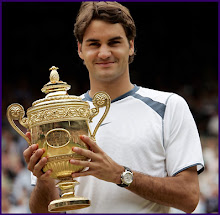WELCOME
Welcome to my Blog.......The best tips on net for tennis. Click here, if VISITING FOR THE FIRST TIME.
Also dont forget to visit my new website WWW.BHARATVERMA.IN
Also dont forget to visit my new website WWW.BHARATVERMA.IN
Support Us
Saturday, June 30, 2007
Wednesday, June 27, 2007
Tuesday, June 19, 2007
Thursday, June 14, 2007
Saturday, June 09, 2007
Saturday, June 02, 2007
Five Things to Learn from Roger Federer
 Federer Moving ForwardFive things you can learn from Roger Federer’s victory in the 2004 U.S. Open men’s final.
Federer Moving ForwardFive things you can learn from Roger Federer’s victory in the 2004 U.S. Open men’s final.1. KICK IT OLD SCHOOL
I like to say that Roger Federer has brought the old-school game of tennis to the modern world. He plays with tremendous variety of shot and strategy, and it was all on display in his 6-0, 7-6 (3), 6-0 rout of Lleyton Hewitt, a player whose tenacity usually gives his opponents fits. What Federer shows is that there is no substitute for being a well-rounded player and having options when you step on the court.
2. BE PATIENT
Because Hewitt plays a conservative, defensive style, it was up to Federer to decide when to go on the offensive. Hewitt couldn’t hurt him from the baseline, so Federer waited for a ball that would allow him to take control of the point. When you face a determined counterpuncher, try not to get overeager. The surest way to defeat such an opponent is to be patient and work each point until you have a clear opening.
3. HANG TOUGH
Even though Hewitt lost the first eight games, he still fought hard. If he had gotten a few lucky breaks he would have been back in the match. When you’re playing an opponent who is on fire, keep making him hit shots. If he continues to hit winners, then he’s too good that day. But many times you’ll weather the storm. Federer cooled off considerably in the second set, and Hewitt kept plugging away and nearly stole it.
4. PLAY BIG IN THE BREAKER
Federer realized the importance of the secondset tiebreaker. Winning it would give him a two-set lead and destroy the momentum Hewitt had gained by clawing his way back into the match. Federer elevated his game and reeled off the first four points of the breaker. Instead of trying to take the initiative, Hewitt played the points hoping Federer would make errors. You have to put a premium on every point in a tiebreaker. Play each one as if it’s a break point.
5. TAKE THE BALL EARLY
Federer’s ability to move from well behind the baseline to the middle of the court, from defense to offense, is unbelievable. Once he recognizes that a ball is going to be short, he moves up to take it early. That’s how he hit most of his winners against Hewitt. If you take the ball even a half-second earlier, that’s better than adding 10 m.p.h. to your shot because you’re being aggressive while still playing within your comfort zone.
Subscribe to:
Comments (Atom)

